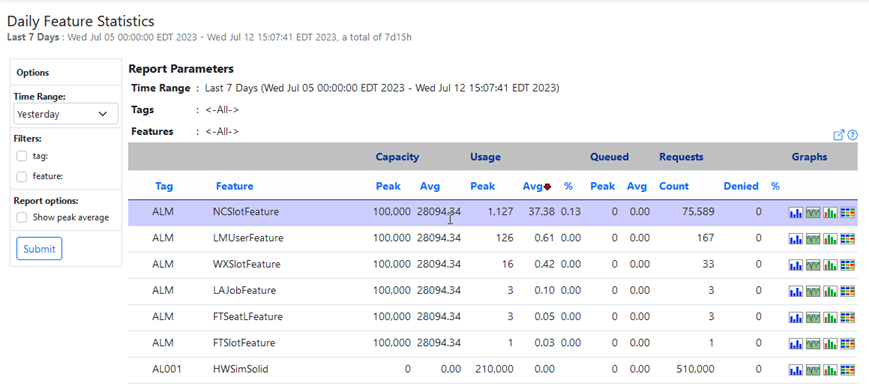Generate a Usage Report
License utilization report.
-
Go to the History tab and click on the
Usage drop down menu.

Figure 1. History PageFrom the Usage option, you can generate the following 11 types of web GUI reports:
- Daily Feature Statistics
- An overview of availability and utilization statistics for a time frame.
- Daily Feature Plots
- A graph of the metrics shown on the Feature Statistics page for a specific tag/feature combination.
- Efficiency Statistics
- A table showing the metrics associated with efficient license usage.
- Efficiency Histogram
- A graph that shows license availability. It can show both licensing bottlenecks and waste.
- Detailed Plots
- A group of graphs, which shows availability and utilization statistics.
- Heatmap
- A report, which shows a time period, represented as a 24x7 clock view.
- Checkout Statistics
- A report that can show pin-pointed data about license utilization.
- Checkout Details
- A report that shows the actual checkouts shown in the Statistics view.
- Duration Histogram
- A graph that shows the distribution of checkouts based on duration.
- Usage Comparison Plot
- A graph, which accompanies the checkout statistics page, and allows for complex report-by and filter options.
- Usage Trends
- A report on one or more features over a specified time frame.
-
In this example, you will generate a daily feature statistics report. To do so,
select Daily Feature Statistics from the drop-down list.
The first time you pull up a report, it will be blank.

Figure 2. Daily Feature Statistics - Enter a time range from the drop-down list.
- Click on a Tag or a Feature, and narrow the search by a Tag or Feature, as desired. You can also enter a wild card search.
-
Click Submit.
The report will refresh with your new terms.
- Optional:
You can convert this report to a batch report, by clicking Convert
to a Batch Report, which is located beneath the Submit button.
It’s in small blue print. This saves your report, and you can rerun it, without
having to enter report parameters again.
After clicking on the link, you will advance to the Batch Report page.
- Enter a name for your report, and click Create Reports at the bottom of the page. When you log in, your report will be available from the Batch Report page until you delete it.